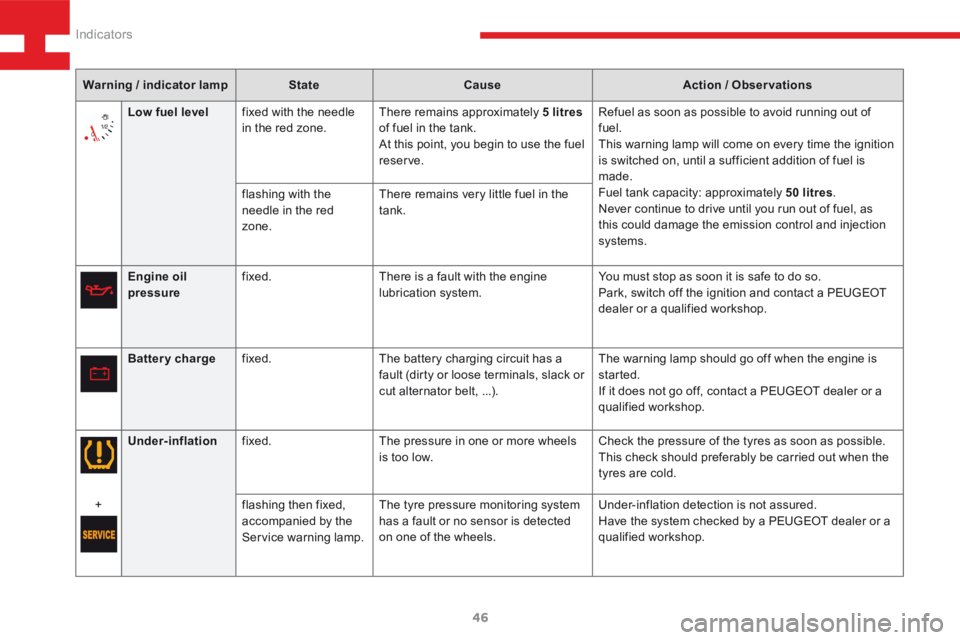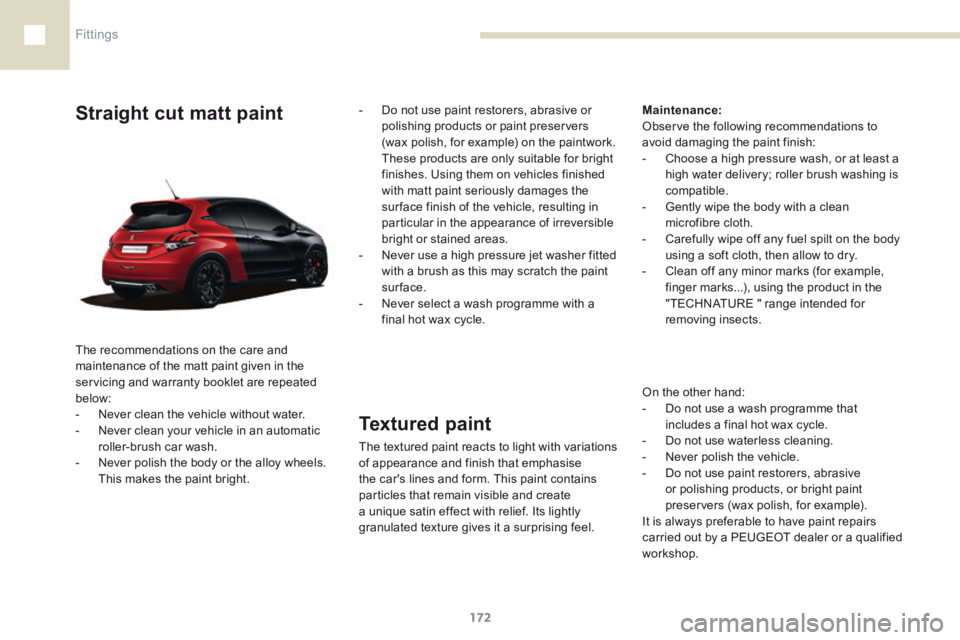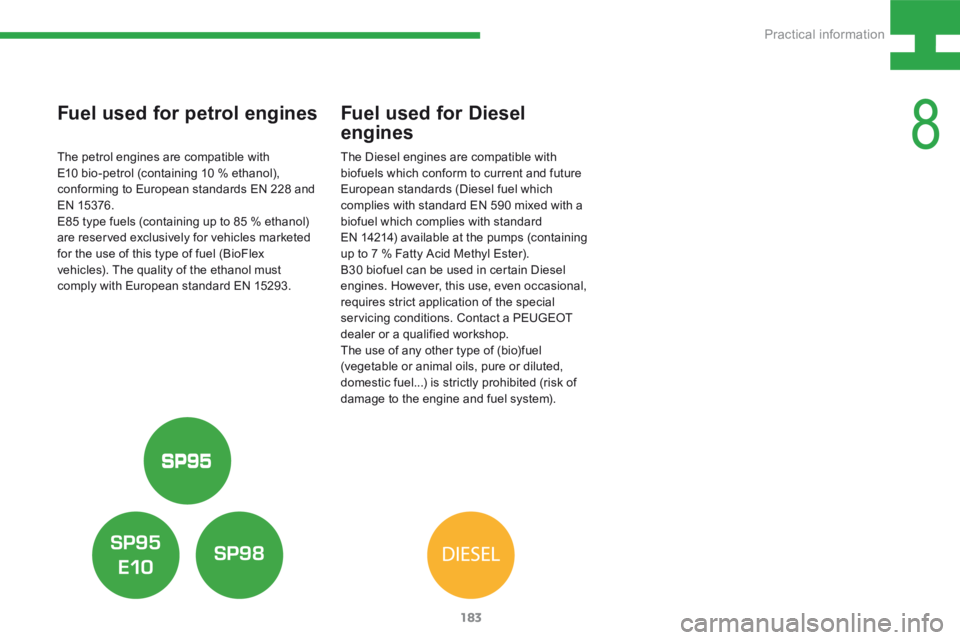Page 48 of 341

46
208_en_Chap03_Indicateurs_ed01-2015
Warning / indicator lampStateCause Action / Observations
Engine oil
pressure fixed.
There is a fault with the engine
lubrication system. You must stop as soon it is safe to do so.
Park, switch off the ignition and contact a PEUGEOT
dealer or a qualified workshop.
Battery charge fixed. The battery charging circuit has a
fault (dirty or loose terminals, slack or
cut alternator belt, ...). The warning lamp should go off when the engine is
started.
If it does not go off, contact a PEUGEOT dealer or a
qualified workshop.
Low fuel level
fixed with the needle
in the red zone. There remains approximately 5 litres
of fuel in the tank.
At this point, you begin to use the fuel
reserve. Refuel as soon as possible to avoid running out of
fuel.
This warning lamp will come on every time the ignition
is switched on, until a sufficient addition of fuel is
made.
Fuel tank capacity: approximately 50 litres
.
Never continue to drive until you run out of fuel, as
this could damage the emission control and injection
systems.
flashing with the
needle in the red
zone.
There remains very little fuel in the
tank.
Under-inflation fixed. The pressure in one or more wheels
is too low. Check the pressure of the tyres as soon as possible.
This check should preferably be carried out when the
tyres are cold.
+ flashing then fixed,
accompanied by the
Service warning lamp.The tyre pressure monitoring system
has a fault or no sensor is detected
on one of the wheels. Under-inflation detection is not assured.
Have the system checked by a PEUGEOT dealer or a
qualified workshop.
Indicators
Page 174 of 341

172
208_en_Chap07_ Amenagements_ed01-2015
Textured paint
The textured paint reacts to light with variations
of appearance and finish that emphasise
the car's lines and form. This paint contains
particles that remain visible and create
a unique satin effect with relief. Its lightly
granulated texture gives it a surprising feel.
Straight cut matt paintMaintenance:
Observe the following recommendations to
avoid damaging the paint finish:
- Choose a high pressure wash, or at least a
high water delivery; roller brush washing is
compatible.
- Gently wipe the body with a clean
microfibre cloth.
- Carefully wipe off any fuel spilt on the body
using a soft cloth, then allow to dry.
- Clean off any minor marks (for example,
finger marks...), using the product in the
"TECHNATURE " range intended for
removing insects.
The recommendations on the care and
maintenance of the matt paint given in the
servicing and warranty booklet are repeated
below:
- Never clean the vehicle without water.
- Never clean your vehicle in an automatic
roller-brush car wash.
- Never polish the body or the alloy wheels.
This makes the paint bright. -
Do not use paint restorers, abrasive or
polishing products or paint preservers
(wax polish, for example) on the paintwork.
These products are only suitable for bright
finishes. Using them on vehicles finished
with matt paint seriously damages the
sur face finish of the vehicle, resulting in
particular in the appearance of irreversible
bright or stained areas.
- Never use a high pressure jet washer fitted
with a brush as this may scratch the paint
sur face.
- Never select a wash programme with a
final hot wax cycle.
On the other hand:
- Do not use a wash programme that
includes a final hot wax cycle.
- Do not use waterless cleaning.
- Never polish the vehicle.
- Do not use paint restorers, abrasive
or polishing products, or bright paint
preservers (wax polish, for example).
It is always preferable to have paint repairs
carried out by a PEUGEOT dealer or a qualified
workshop.
Fittings
Page 185 of 341

183
208_en_Chap08_Informations-pratiques_ed01-2015
Fuel used for petrol engines
The petrol engines are compatible with
E10 bio-petrol (containing 10 % ethanol),
conforming to European standards EN 228 and
EN 15376.
E85 type fuels (containing up to 85 % ethanol)
are reserved exclusively for vehicles marketed
for the use of this type of fuel (BioFlex
vehicles). The quality of the ethanol must
comply with European standard EN 15293.
Fuel used for Diesel
engines
The Diesel engines are compatible with
biofuels which conform to current and future
European standards (Diesel fuel which
complies with standard EN 590 mixed with a
biofuel which complies with standard
EN 14214) available at the pumps (containing
up to 7 % Fatty Acid Methyl Ester).
B30 biofuel can be used in certain Diesel
engines. However, this use, even occasional,
requires strict application of the special
servicing conditions. Contact a PEUGEOT
dealer or a qualified workshop.
The use of any other type of (bio)fuel
(vegetable or animal oils, pure or diluted,
domestic fuel...) is strictly prohibited (risk of
damage to the engine and fuel system).
8
Practical information